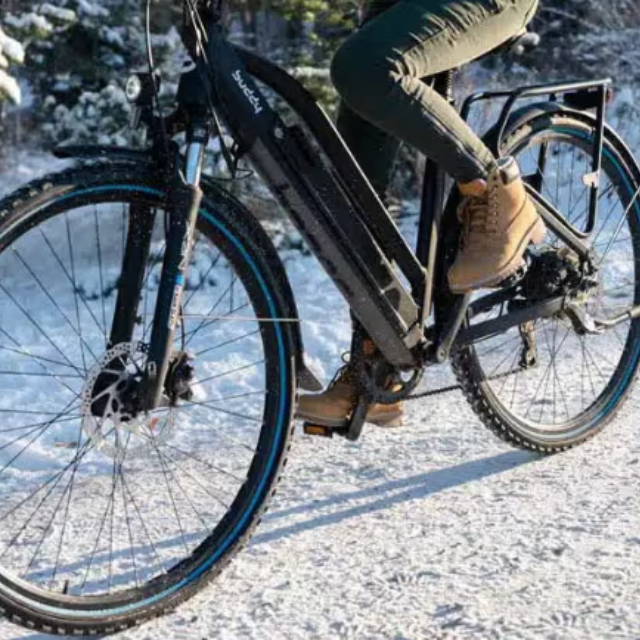Mastering E-Bike Gear Shifting: Tips for Smooth Riding
Written by: Rémy Rossi | March 30, 2025 | Time to read 5 min
Don’t get caught up with numbers and gear ratios— here’s an intuitive guide on how to shift gears on an electric bike.

More about the Author: Remy Rossi
Rémy Rossi is a bike writer, mechanic, and educator who got his start in community-based bike shops and co-ops. With a decade in the industry, he still wrenches on bikes when he can and plays bike polo on a fixie.

What gears do on an e-Bike

If you ride downhill and start going faster, you’ll need to shift into a higher gear to maintain the ideal cadence. Inversely, heading uphill means you’ll want a lower, easier gear to keep pedaling with an efficient rhythm.
How to shift gears on an e-Bike

Those rear gears are controlled by a shifter on the right side of the handlebars. You may have a grip shifter, thumb shifter, road levers, or trigger shifter to toggle through the gears.
The smallest cog is the highest gear, which you’ll want to use when traveling fast. That small gear moves the rear wheel further with every pedal rotation, requiring more effort to pedal, but you’ll travel a longer distance.
The largest cog is the innermost one, and this lowest gear is easiest to pedal. When pedaling uphill or accelerating from a stopped position, you’ll want to use these lower gears that require less effort, which help you reach an efficient cadence when the going gets tough.
The same logic applies to internally geared e-Bikes. You’ll see the numbers (high number for small gears, low number for big gears) and can orient yourself that way.
🤝 Why you can trust us for buying an e-Bike?
- Great prices: Get your next e-Bike for up to 60% off retail prices, in new or like-new conditions.
- Quality Guaranteed: Every e-Bike is rigorously certified by a team of professional mechanics, and comes with a 1-year warranty.
- Delivered to Your Door: Delivered to your home within a week. Change your mind? Return it thanks to our 14-day return policy.
Why it’s important to shift gears
Shifting into the correct gear helps keep your pedaling cadence consistent. Without gears, your pedaling rate would always match up with your speed— fast downhills and you’d be spinning out, and slow uphills would lead to sluggish grinding on the pedals. I ride a fixed gear bike (only one gear) and I know this situation well, but my city is fairly flat, so it’s not too much of a problem.

- Smooth, effective pedal assist: E-Bikes— especially ones with mid-drive motors— work with the gears to provide the most natural and efficient amount of boost. Being in the right
- No stalling out: Being in too hard of a gear means your pedaling may slow down to such a point that the motor doesn’t know that you need a boost. This is especially true for e-Bikes with cadence sensors rather than torque sensors. When accelerating or going uphill, ride in a low enough gear to maintain an adequate cadence, and the motor will keep assisting as it should.
- Avoid ghost pedaling: Riding in too low of a gear and high pedal assist level may lead to ghost pedaling. This occurs when the motor assistance is much stronger than your pedal power— you push on the pedals, but the low gear prevents you from adding much force. Click down a few gears and you’ll feel that your pedaling better matches the selected pedal assist level.
- Extend your range: Smooth pedaling and proper gear selection will maximize your motorized bike battery’s range. By selecting the right gear, you’ll always be providing human pedal power that combines with the motor’s boost, drawing less energy from the battery alone.
E-Bike gear shifting tips
Lighten your pedal stroke when shifting
Close your eyes (but not really)

Shifting is all about what feels natural for your body and the pedaling speed that feels right in the moment. As you continue to ride, proper shifting technique will become second-nature and you won’t have to think about the specific gear you’re in, but rather just make small shifts when necessary.
Key Takeaways
- Shift for Efficiency: Proper gear shifting keeps your pedaling smooth and maximizes motor assist for a better ride.
- Match Gears to Terrain: Use higher gears for speed and lower gears for climbs, shifting early to avoid strain.
- Boost Performance & Battery Life: Good shifting prevents stalling, ghost pedaling, and battery drain, ensuring a smoother, longer ride.


